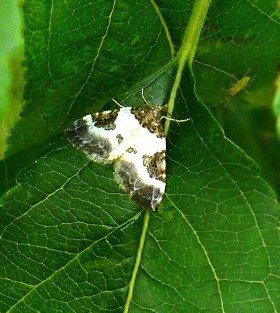
Rainfall for June was a moderate 53.7 mm, but 19 mm of this fell on the 6th, and 20mm on the 28th, leaving a paltry 14.7 mm for the rest of the month. Temperatures were generally very warm, reaching 30⁰ C on the 21st with 19 days during the month having a maximum daytime temperature of 20⁰ C or more. The coldest day was the 6th, with a maximum temperature of 15⁰ C. There were fresh-to-strong winds between the 5th and the 8th, with many green leaves being stripped from the trees, and small and medium sized dead branches coming down in the woodland on the 6th, when force 7 gusts were felt for much of the day. Perhaps the magpies knew what they were doing last December 13th, when they started building their nest in a low hawthorn instead of at the top of a tall oak tree.
-
 Blue-bordered carpet moth
Blue-bordered carpet moth
Blue-bordered carpet moth
Blue-bordered carpet moth
-
 Sawfly larva Dolerus ferrugatus (maybe)
Sawfly larva Dolerus ferrugatus (maybe)
Sawfly larva Dolerus ferrugatus (maybe)
Sawfly larva Dolerus ferrugatus (maybe)
-
 June wildflowers - predominantly bird's foot trefoil, meadow vetchling, and tufted vetch
June wildflowers - predominantly bird's foot trefoil, meadow vetchling, and tufted vetch
June wildflowers - predominantly bird's foot trefoil, meadow vetchling, and tufted vetch
June wildflowers - predominantly bird's foot trefoil, meadow vetchling, and tufted vetch
-
 Pyrausta purpuralis micro moth
Pyrausta purpuralis micro moth
Pyrausta purpuralis micro moth
Pyrausta purpuralis micro moth
https://kentfieldclub.org.uk/index.php?view=article&catid=23%3Alittle-barton-farm-wildlife-notes-&id=73%3Ajune-2017&tmpl=component&print=1&layout=default&page=&option=com_content&Itemid=22#sigProIddf72f64613
The warm weather encouraged the flowering of 16 more species this month, bringing our total to 48 for the year so far. We spotted marsh bedstraw beside the lake and foxglove in the wood on June 1st. This was followed by hedge woundwort beside the woodland ponds on the 10th; nipplewort in the garden and honeysuckle in the wood on the 12th; agrimony in the flower meadow and dark mullein around the garden on the 14th, and self-heal in the flower meadow on the 15th. Sow thistle, meadow vetchling, yarrow, and knapweed bloomed in the fields on the 16th, 16th,17th, and 19th respectively while field bindweed beside the lake on the 20th, marsh woundwort in the fields on the 22nd, hedge bindweed beside the lake on the 24th, and redshank on the 27th completed the wild flower tally for the month.
With seven butterfly species making their first appearance, we have now reached 21 species for the year. On June 1st our first large skipper appeared in the field beside our garden. A fortnight later, a rather early white admiral arrived on the 15th, to be followed by the first of six marbled whites in the wildflower meadow on the 22nd. Next morning, on the 23rd, we found a pristine silver washed fritillary repeatedly opening and closing its wings on bramble blossom in the woodland. The first small skipper we were aware of was found among grasses on the 26th, while the 28th produced sightings of our first gatekeeper and ringlet in the same permanent grass and wildflower meadow, the latter an infrequent arrival for the second year in succession. Nine new moth-sightings occurred this month including two on the 1st, these being a blood vein moth on waterside iris, and green oak tortrix moth on the woodland floor. On the 3rd, a snout moth came to light in our upstairs bathroom. These were followed by two further waterside moths, the small china mark moth among rushes at the woodland pond (9th), and the brown china mark moth on marginal plants by the lake (11th). The 12th provided our first known record of a blue-bordered carpet moth on the underside of an apple tree leaf, while a large yellow underwing turned up in our log shed on the 16th. Finally, two moths associated with grassland habitats, the colourful micro-moth Pyrausta purpularis (26th), and the mother of pearl moth (28th) completed our month’s sightings. However, we consulted three specialist recorders about the identity of a green and yellow lakeside larva with spots which we photographed on June 22nd thinking it was moth-related. The third specialist informed us it may be the larva of a sawfly Dolerus ferrugatus. If you Google this, species you will be directed to ‘Nature Spot’ and a near- identical image. Many thanks to the three recorders Involved in this process.
Two new dragonfly sightings this month brought our total species-count to 14. We witnessed the maiden flight of a common darter on the 19th, but could not find an exuvia of another one until the 23rd. Our first-sighting of a brown hawker was in the woodland ride hunting insects on the 25th (no exuvia yet found). Interestingly, although we have often found partly-devoured damselflies in spider webs beside the lake, we found the remains of our first ever spider-damaged dragonfly on the 14th, when we spotted the head and wings of a four-spotted chaser (chunky and 44-48 mm long) ensnared by a web of a long-legged spider, which beat a hasty retreat when I collected the exuvia further down the rush. The abdomen had been eaten completely.
There were no new bird species seen this month, but the turtle dove – first heard on May 28th was last heard in the locality on June 14th, while the cuckoo, first heard on April 24th, was last heard on June 2nd.